Middle Eastern Politics and Conflicts
VerifiedAdded on 2023/06/11
|8
|2016
|149
AI Summary
This article delves into the root causes of the Iraq War, Syrian Conflict, and rise of Islamic fundamentalism in the Middle East. It explores the impact of foreign involvement and vested interests in the region. The article also discusses the history of the Middle East, including the tribal and feudal culture, the Ottoman rule, and the discovery of petroleum oil. The subject matter is relevant to courses in Middle Eastern studies, international relations, and political science.
Contribute Materials
Your contribution can guide someone’s learning journey. Share your
documents today.
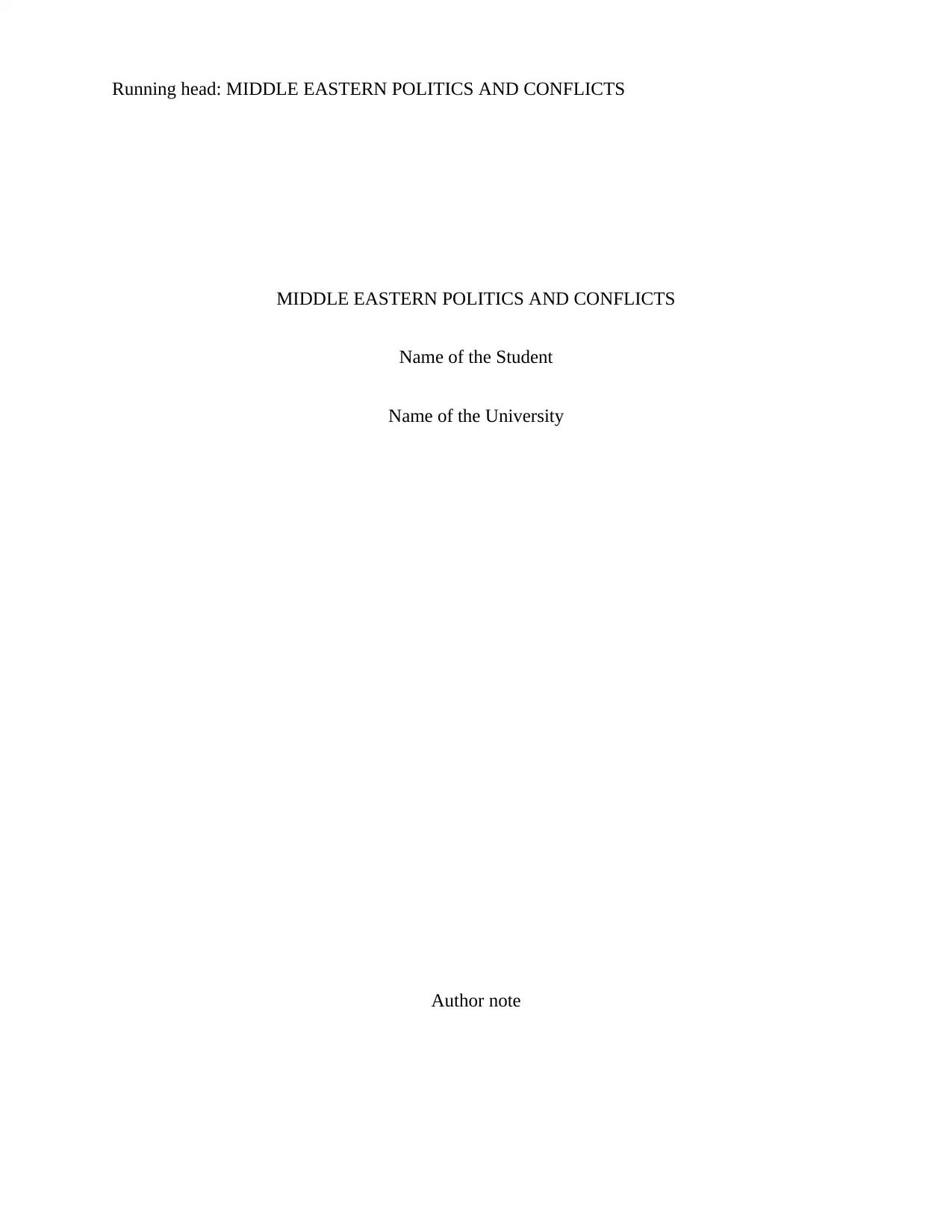
Running head: MIDDLE EASTERN POLITICS AND CONFLICTS
MIDDLE EASTERN POLITICS AND CONFLICTS
Name of the Student
Name of the University
Author note
MIDDLE EASTERN POLITICS AND CONFLICTS
Name of the Student
Name of the University
Author note
Secure Best Marks with AI Grader
Need help grading? Try our AI Grader for instant feedback on your assignments.
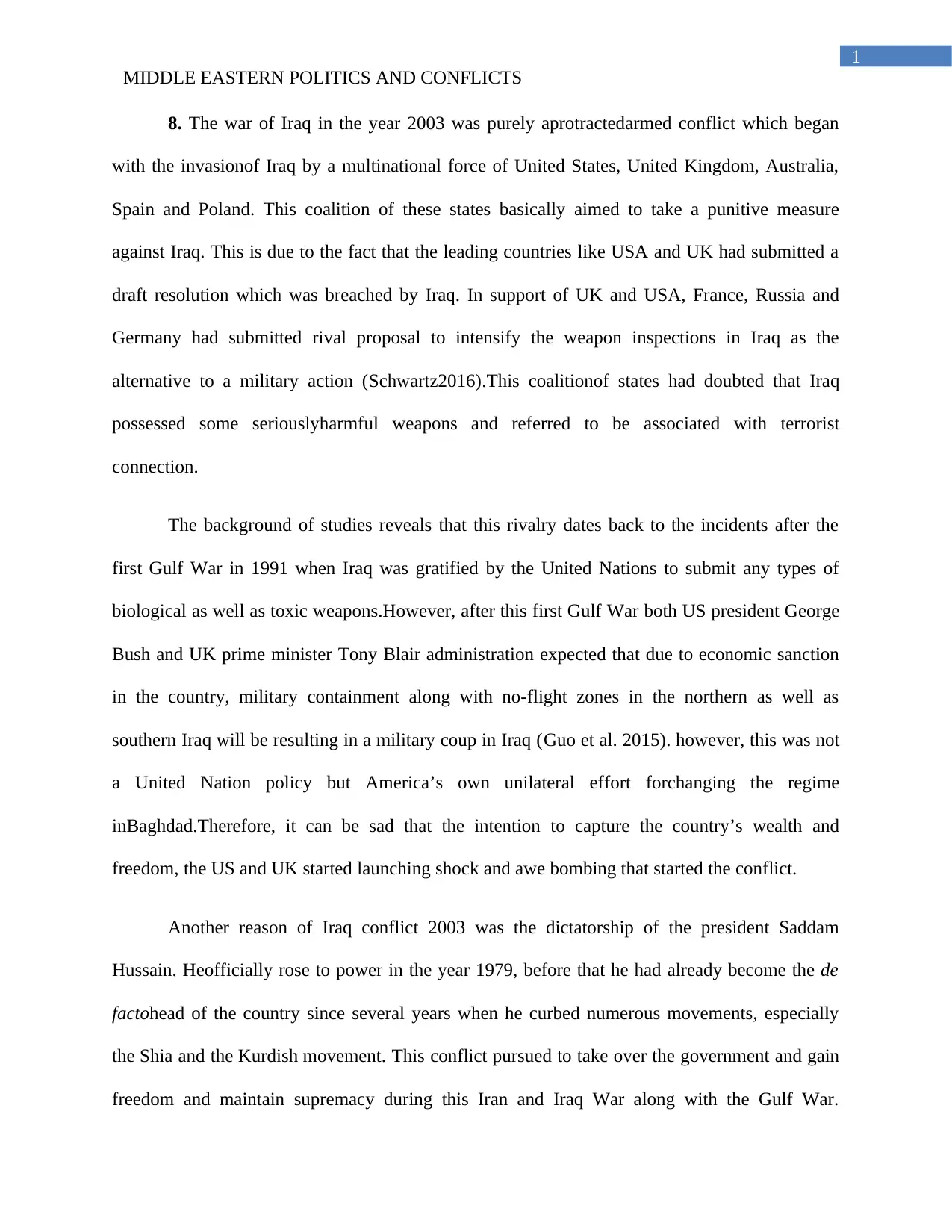
1
MIDDLE EASTERN POLITICS AND CONFLICTS
8. The war of Iraq in the year 2003 was purely aprotractedarmed conflict which began
with the invasionof Iraq by a multinational force of United States, United Kingdom, Australia,
Spain and Poland. This coalition of these states basically aimed to take a punitive measure
against Iraq. This is due to the fact that the leading countries like USA and UK had submitted a
draft resolution which was breached by Iraq. In support of UK and USA, France, Russia and
Germany had submitted rival proposal to intensify the weapon inspections in Iraq as the
alternative to a military action (Schwartz2016).This coalitionof states had doubted that Iraq
possessed some seriouslyharmful weapons and referred to be associated with terrorist
connection.
The background of studies reveals that this rivalry dates back to the incidents after the
first Gulf War in 1991 when Iraq was gratified by the United Nations to submit any types of
biological as well as toxic weapons.However, after this first Gulf War both US president George
Bush and UK prime minister Tony Blair administration expected that due to economic sanction
in the country, military containment along with no-flight zones in the northern as well as
southern Iraq will be resulting in a military coup in Iraq (Guo et al. 2015). however, this was not
a United Nation policy but America’s own unilateral effort forchanging the regime
inBaghdad.Therefore, it can be sad that the intention to capture the country’s wealth and
freedom, the US and UK started launching shock and awe bombing that started the conflict.
Another reason of Iraq conflict 2003 was the dictatorship of the president Saddam
Hussain. Heofficially rose to power in the year 1979, before that he had already become the de
factohead of the country since several years when he curbed numerous movements, especially
the Shia and the Kurdish movement. This conflict pursued to take over the government and gain
freedom and maintain supremacy during this Iran and Iraq War along with the Gulf War.
MIDDLE EASTERN POLITICS AND CONFLICTS
8. The war of Iraq in the year 2003 was purely aprotractedarmed conflict which began
with the invasionof Iraq by a multinational force of United States, United Kingdom, Australia,
Spain and Poland. This coalition of these states basically aimed to take a punitive measure
against Iraq. This is due to the fact that the leading countries like USA and UK had submitted a
draft resolution which was breached by Iraq. In support of UK and USA, France, Russia and
Germany had submitted rival proposal to intensify the weapon inspections in Iraq as the
alternative to a military action (Schwartz2016).This coalitionof states had doubted that Iraq
possessed some seriouslyharmful weapons and referred to be associated with terrorist
connection.
The background of studies reveals that this rivalry dates back to the incidents after the
first Gulf War in 1991 when Iraq was gratified by the United Nations to submit any types of
biological as well as toxic weapons.However, after this first Gulf War both US president George
Bush and UK prime minister Tony Blair administration expected that due to economic sanction
in the country, military containment along with no-flight zones in the northern as well as
southern Iraq will be resulting in a military coup in Iraq (Guo et al. 2015). however, this was not
a United Nation policy but America’s own unilateral effort forchanging the regime
inBaghdad.Therefore, it can be sad that the intention to capture the country’s wealth and
freedom, the US and UK started launching shock and awe bombing that started the conflict.
Another reason of Iraq conflict 2003 was the dictatorship of the president Saddam
Hussain. Heofficially rose to power in the year 1979, before that he had already become the de
factohead of the country since several years when he curbed numerous movements, especially
the Shia and the Kurdish movement. This conflict pursued to take over the government and gain
freedom and maintain supremacy during this Iran and Iraq War along with the Gulf War.
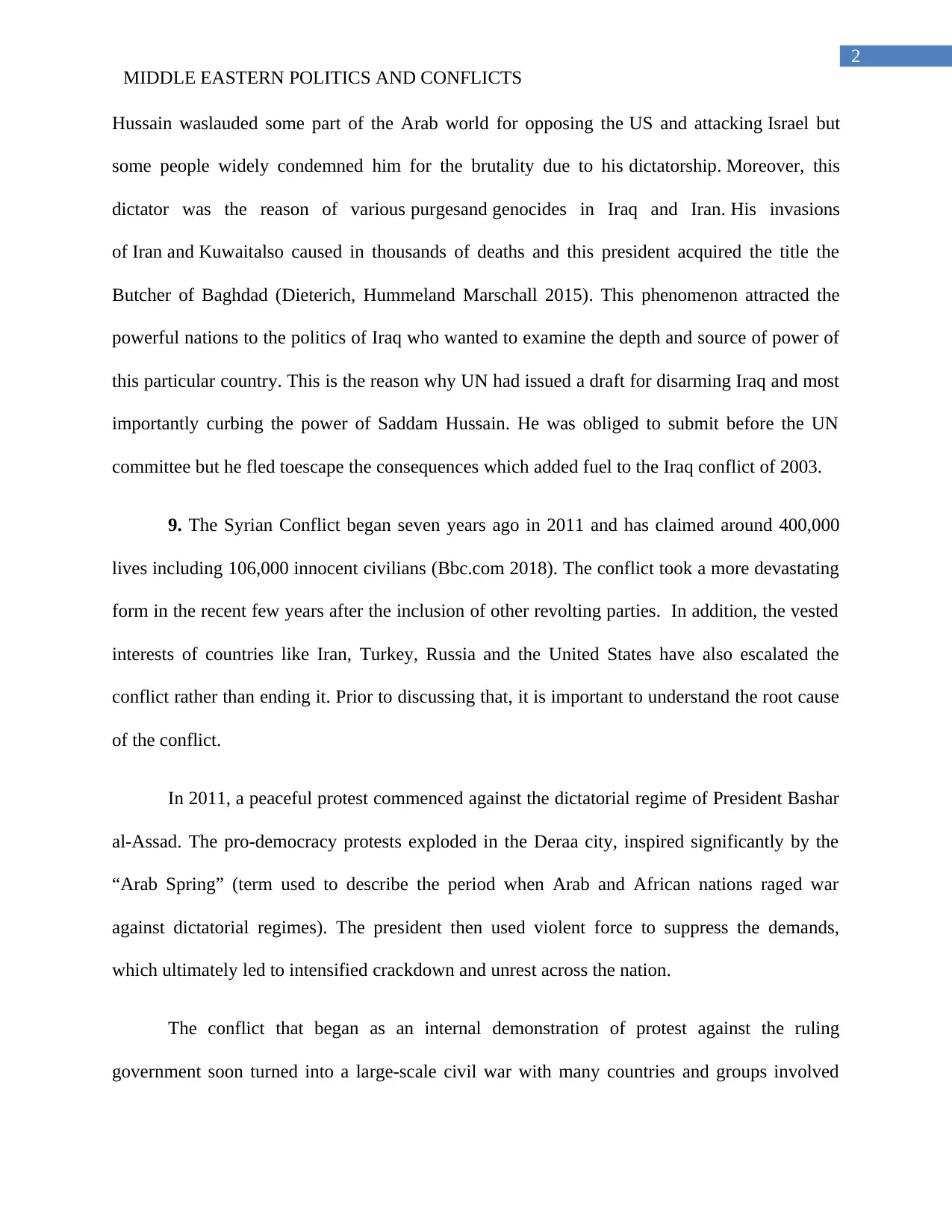
2
MIDDLE EASTERN POLITICS AND CONFLICTS
Hussain waslauded some part of the Arab world for opposing the US and attacking Israel but
some people widely condemned him for the brutality due to his dictatorship. Moreover, this
dictator was the reason of various purgesand genocides in Iraq and Iran. His invasions
of Iran and Kuwaitalso caused in thousands of deaths and this president acquired the title the
Butcher of Baghdad (Dieterich, Hummeland Marschall 2015). This phenomenon attracted the
powerful nations to the politics of Iraq who wanted to examine the depth and source of power of
this particular country. This is the reason why UN had issued a draft for disarming Iraq and most
importantly curbing the power of Saddam Hussain. He was obliged to submit before the UN
committee but he fled toescape the consequences which added fuel to the Iraq conflict of 2003.
9. The Syrian Conflict began seven years ago in 2011 and has claimed around 400,000
lives including 106,000 innocent civilians (Bbc.com 2018). The conflict took a more devastating
form in the recent few years after the inclusion of other revolting parties. In addition, the vested
interests of countries like Iran, Turkey, Russia and the United States have also escalated the
conflict rather than ending it. Prior to discussing that, it is important to understand the root cause
of the conflict.
In 2011, a peaceful protest commenced against the dictatorial regime of President Bashar
al-Assad. The pro-democracy protests exploded in the Deraa city, inspired significantly by the
“Arab Spring” (term used to describe the period when Arab and African nations raged war
against dictatorial regimes). The president then used violent force to suppress the demands,
which ultimately led to intensified crackdown and unrest across the nation.
The conflict that began as an internal demonstration of protest against the ruling
government soon turned into a large-scale civil war with many countries and groups involved
MIDDLE EASTERN POLITICS AND CONFLICTS
Hussain waslauded some part of the Arab world for opposing the US and attacking Israel but
some people widely condemned him for the brutality due to his dictatorship. Moreover, this
dictator was the reason of various purgesand genocides in Iraq and Iran. His invasions
of Iran and Kuwaitalso caused in thousands of deaths and this president acquired the title the
Butcher of Baghdad (Dieterich, Hummeland Marschall 2015). This phenomenon attracted the
powerful nations to the politics of Iraq who wanted to examine the depth and source of power of
this particular country. This is the reason why UN had issued a draft for disarming Iraq and most
importantly curbing the power of Saddam Hussain. He was obliged to submit before the UN
committee but he fled toescape the consequences which added fuel to the Iraq conflict of 2003.
9. The Syrian Conflict began seven years ago in 2011 and has claimed around 400,000
lives including 106,000 innocent civilians (Bbc.com 2018). The conflict took a more devastating
form in the recent few years after the inclusion of other revolting parties. In addition, the vested
interests of countries like Iran, Turkey, Russia and the United States have also escalated the
conflict rather than ending it. Prior to discussing that, it is important to understand the root cause
of the conflict.
In 2011, a peaceful protest commenced against the dictatorial regime of President Bashar
al-Assad. The pro-democracy protests exploded in the Deraa city, inspired significantly by the
“Arab Spring” (term used to describe the period when Arab and African nations raged war
against dictatorial regimes). The president then used violent force to suppress the demands,
which ultimately led to intensified crackdown and unrest across the nation.
The conflict that began as an internal demonstration of protest against the ruling
government soon turned into a large-scale civil war with many countries and groups involved
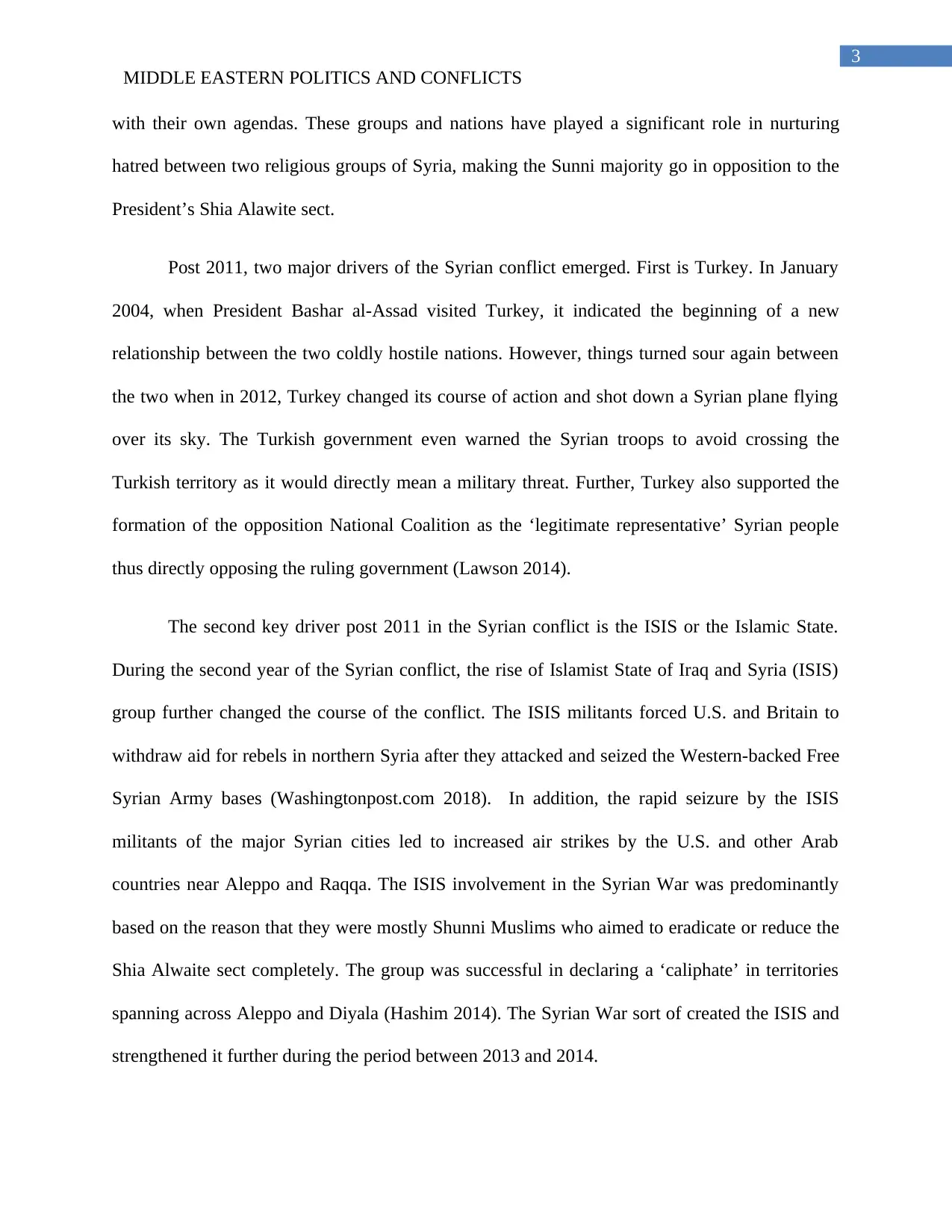
3
MIDDLE EASTERN POLITICS AND CONFLICTS
with their own agendas. These groups and nations have played a significant role in nurturing
hatred between two religious groups of Syria, making the Sunni majority go in opposition to the
President’s Shia Alawite sect.
Post 2011, two major drivers of the Syrian conflict emerged. First is Turkey. In January
2004, when President Bashar al-Assad visited Turkey, it indicated the beginning of a new
relationship between the two coldly hostile nations. However, things turned sour again between
the two when in 2012, Turkey changed its course of action and shot down a Syrian plane flying
over its sky. The Turkish government even warned the Syrian troops to avoid crossing the
Turkish territory as it would directly mean a military threat. Further, Turkey also supported the
formation of the opposition National Coalition as the ‘legitimate representative’ Syrian people
thus directly opposing the ruling government (Lawson 2014).
The second key driver post 2011 in the Syrian conflict is the ISIS or the Islamic State.
During the second year of the Syrian conflict, the rise of Islamist State of Iraq and Syria (ISIS)
group further changed the course of the conflict. The ISIS militants forced U.S. and Britain to
withdraw aid for rebels in northern Syria after they attacked and seized the Western-backed Free
Syrian Army bases (Washingtonpost.com 2018). In addition, the rapid seizure by the ISIS
militants of the major Syrian cities led to increased air strikes by the U.S. and other Arab
countries near Aleppo and Raqqa. The ISIS involvement in the Syrian War was predominantly
based on the reason that they were mostly Shunni Muslims who aimed to eradicate or reduce the
Shia Alwaite sect completely. The group was successful in declaring a ‘caliphate’ in territories
spanning across Aleppo and Diyala (Hashim 2014). The Syrian War sort of created the ISIS and
strengthened it further during the period between 2013 and 2014.
MIDDLE EASTERN POLITICS AND CONFLICTS
with their own agendas. These groups and nations have played a significant role in nurturing
hatred between two religious groups of Syria, making the Sunni majority go in opposition to the
President’s Shia Alawite sect.
Post 2011, two major drivers of the Syrian conflict emerged. First is Turkey. In January
2004, when President Bashar al-Assad visited Turkey, it indicated the beginning of a new
relationship between the two coldly hostile nations. However, things turned sour again between
the two when in 2012, Turkey changed its course of action and shot down a Syrian plane flying
over its sky. The Turkish government even warned the Syrian troops to avoid crossing the
Turkish territory as it would directly mean a military threat. Further, Turkey also supported the
formation of the opposition National Coalition as the ‘legitimate representative’ Syrian people
thus directly opposing the ruling government (Lawson 2014).
The second key driver post 2011 in the Syrian conflict is the ISIS or the Islamic State.
During the second year of the Syrian conflict, the rise of Islamist State of Iraq and Syria (ISIS)
group further changed the course of the conflict. The ISIS militants forced U.S. and Britain to
withdraw aid for rebels in northern Syria after they attacked and seized the Western-backed Free
Syrian Army bases (Washingtonpost.com 2018). In addition, the rapid seizure by the ISIS
militants of the major Syrian cities led to increased air strikes by the U.S. and other Arab
countries near Aleppo and Raqqa. The ISIS involvement in the Syrian War was predominantly
based on the reason that they were mostly Shunni Muslims who aimed to eradicate or reduce the
Shia Alwaite sect completely. The group was successful in declaring a ‘caliphate’ in territories
spanning across Aleppo and Diyala (Hashim 2014). The Syrian War sort of created the ISIS and
strengthened it further during the period between 2013 and 2014.
Secure Best Marks with AI Grader
Need help grading? Try our AI Grader for instant feedback on your assignments.
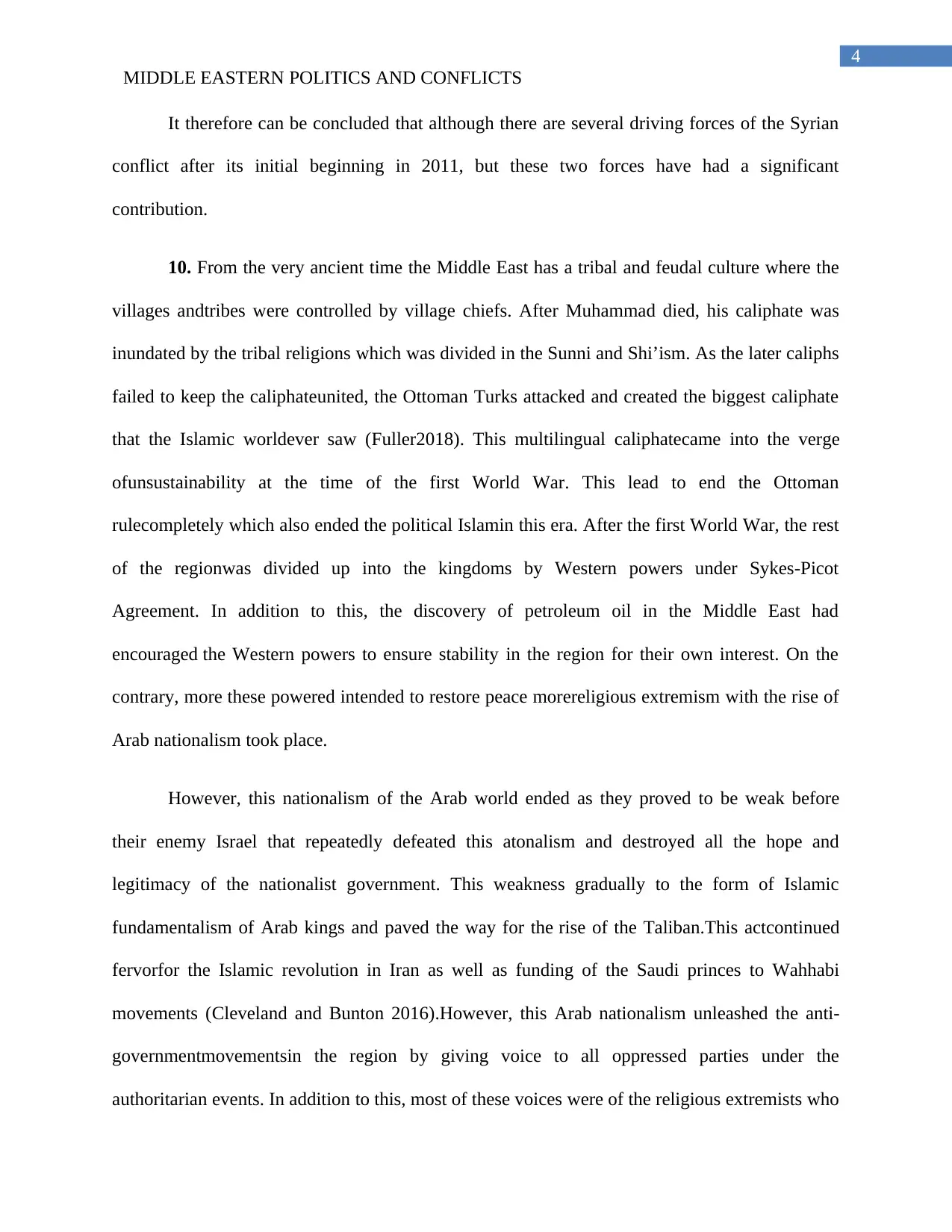
4
MIDDLE EASTERN POLITICS AND CONFLICTS
It therefore can be concluded that although there are several driving forces of the Syrian
conflict after its initial beginning in 2011, but these two forces have had a significant
contribution.
10. From the very ancient time the Middle East has a tribal and feudal culture where the
villages andtribes were controlled by village chiefs. After Muhammad died, his caliphate was
inundated by the tribal religions which was divided in the Sunni and Shi’ism. As the later caliphs
failed to keep the caliphateunited, the Ottoman Turks attacked and created the biggest caliphate
that the Islamic worldever saw (Fuller2018). This multilingual caliphatecame into the verge
ofunsustainability at the time of the first World War. This lead to end the Ottoman
rulecompletely which also ended the political Islamin this era. After the first World War, the rest
of the regionwas divided up into the kingdoms by Western powers under Sykes-Picot
Agreement. In addition to this, the discovery of petroleum oil in the Middle East had
encouraged the Western powers to ensure stability in the region for their own interest. On the
contrary, more these powered intended to restore peace morereligious extremism with the rise of
Arab nationalism took place.
However, this nationalism of the Arab world ended as they proved to be weak before
their enemy Israel that repeatedly defeated this atonalism and destroyed all the hope and
legitimacy of the nationalist government. This weakness gradually to the form of Islamic
fundamentalism of Arab kings and paved the way for the rise of the Taliban.This actcontinued
fervorfor the Islamic revolution in Iran as well as funding of the Saudi princes to Wahhabi
movements (Cleveland and Bunton 2016).However, this Arab nationalism unleashed the anti-
governmentmovementsin the region by giving voice to all oppressed parties under the
authoritarian events. In addition to this, most of these voices were of the religious extremists who
MIDDLE EASTERN POLITICS AND CONFLICTS
It therefore can be concluded that although there are several driving forces of the Syrian
conflict after its initial beginning in 2011, but these two forces have had a significant
contribution.
10. From the very ancient time the Middle East has a tribal and feudal culture where the
villages andtribes were controlled by village chiefs. After Muhammad died, his caliphate was
inundated by the tribal religions which was divided in the Sunni and Shi’ism. As the later caliphs
failed to keep the caliphateunited, the Ottoman Turks attacked and created the biggest caliphate
that the Islamic worldever saw (Fuller2018). This multilingual caliphatecame into the verge
ofunsustainability at the time of the first World War. This lead to end the Ottoman
rulecompletely which also ended the political Islamin this era. After the first World War, the rest
of the regionwas divided up into the kingdoms by Western powers under Sykes-Picot
Agreement. In addition to this, the discovery of petroleum oil in the Middle East had
encouraged the Western powers to ensure stability in the region for their own interest. On the
contrary, more these powered intended to restore peace morereligious extremism with the rise of
Arab nationalism took place.
However, this nationalism of the Arab world ended as they proved to be weak before
their enemy Israel that repeatedly defeated this atonalism and destroyed all the hope and
legitimacy of the nationalist government. This weakness gradually to the form of Islamic
fundamentalism of Arab kings and paved the way for the rise of the Taliban.This actcontinued
fervorfor the Islamic revolution in Iran as well as funding of the Saudi princes to Wahhabi
movements (Cleveland and Bunton 2016).However, this Arab nationalism unleashed the anti-
governmentmovementsin the region by giving voice to all oppressed parties under the
authoritarian events. In addition to this, most of these voices were of the religious extremists who
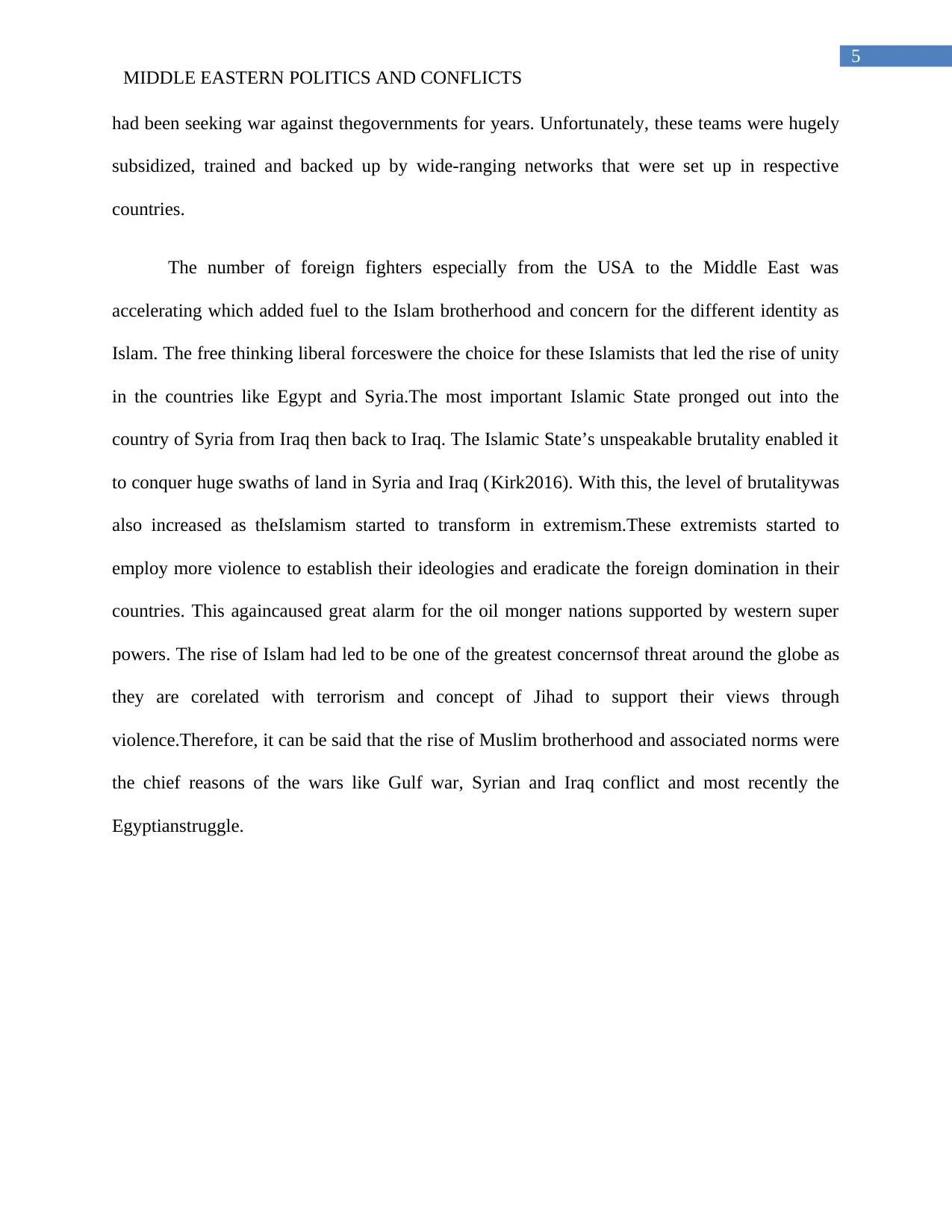
5
MIDDLE EASTERN POLITICS AND CONFLICTS
had been seeking war against thegovernments for years. Unfortunately, these teams were hugely
subsidized, trained and backed up by wide-ranging networks that were set up in respective
countries.
The number of foreign fighters especially from the USA to the Middle East was
accelerating which added fuel to the Islam brotherhood and concern for the different identity as
Islam. The free thinking liberal forceswere the choice for these Islamists that led the rise of unity
in the countries like Egypt and Syria.The most important Islamic State pronged out into the
country of Syria from Iraq then back to Iraq. The Islamic State’s unspeakable brutality enabled it
to conquer huge swaths of land in Syria and Iraq (Kirk2016). With this, the level of brutalitywas
also increased as theIslamism started to transform in extremism.These extremists started to
employ more violence to establish their ideologies and eradicate the foreign domination in their
countries. This againcaused great alarm for the oil monger nations supported by western super
powers. The rise of Islam had led to be one of the greatest concernsof threat around the globe as
they are corelated with terrorism and concept of Jihad to support their views through
violence.Therefore, it can be said that the rise of Muslim brotherhood and associated norms were
the chief reasons of the wars like Gulf war, Syrian and Iraq conflict and most recently the
Egyptianstruggle.
MIDDLE EASTERN POLITICS AND CONFLICTS
had been seeking war against thegovernments for years. Unfortunately, these teams were hugely
subsidized, trained and backed up by wide-ranging networks that were set up in respective
countries.
The number of foreign fighters especially from the USA to the Middle East was
accelerating which added fuel to the Islam brotherhood and concern for the different identity as
Islam. The free thinking liberal forceswere the choice for these Islamists that led the rise of unity
in the countries like Egypt and Syria.The most important Islamic State pronged out into the
country of Syria from Iraq then back to Iraq. The Islamic State’s unspeakable brutality enabled it
to conquer huge swaths of land in Syria and Iraq (Kirk2016). With this, the level of brutalitywas
also increased as theIslamism started to transform in extremism.These extremists started to
employ more violence to establish their ideologies and eradicate the foreign domination in their
countries. This againcaused great alarm for the oil monger nations supported by western super
powers. The rise of Islam had led to be one of the greatest concernsof threat around the globe as
they are corelated with terrorism and concept of Jihad to support their views through
violence.Therefore, it can be said that the rise of Muslim brotherhood and associated norms were
the chief reasons of the wars like Gulf war, Syrian and Iraq conflict and most recently the
Egyptianstruggle.

6
MIDDLE EASTERN POLITICS AND CONFLICTS
References:
Bbc.com 2018. Why is there a war in Syria?. [online] BBC News. Available at:
https://www.bbc.com/news/world-middle-east-35806229 [Accessed 9 Jun. 2018].
Cleveland, W.L. and Bunton, M., 2016. A history of the modern Middle East. Hachette UK.
Dieterich, S., Hummel, H. and Marschall, S., 2015. Bringing democracy back in: The democratic
peace, parliamentary war powers and European participation in the 2003 Iraq War. Cooperation
and Conflict, 50(1), pp.87-106.
Fuller, G., 2018. A sense of siege: The geopolitics of Islam and the West. Routledge.
Hashim, A.S., 2014. The Islamic State: From al‐Qaeda Affiliate to Caliphate. Middle East
Policy, 21(4), pp.69-83.
Kirk, G.E., 2016. A short history of the Middle East: from the rise of Islam to modern times.
Routledge.
Lawson, F.H., 2014. Syria's mutating civil war and its impact on Turkey, Iraq and
Iran. International Affairs, 90(6), pp.1351-1365.
Schwartz, M., 2016. War without end: The Iraq war in context. Haymarket Books.
Washingtonpost.com 2018. [online] Washington Post. Available at:
https://www.washingtonpost.com/world/middle_east/in-syrian-civil-war-emergence-of-islamic-
state-of-iraq-and-syria-boosts-rival-jabhat-al-nusra/2013/10/25/12250760-3b4b-11e3-b0e7-
716179a2c2c7_story.html?noredirect=on&utm_term=.0e38447b22f7 [Accessed 9 Jun. 2018].
Guo, L., Chen, Y.N.K., Vu, H., Wang, Q., Aksamit, R., Guzek, D., Jachimowski, M. and
McCombs, M., 2015. Coverage of the Iraq War in the United States, Mainland China, Taiwan
MIDDLE EASTERN POLITICS AND CONFLICTS
References:
Bbc.com 2018. Why is there a war in Syria?. [online] BBC News. Available at:
https://www.bbc.com/news/world-middle-east-35806229 [Accessed 9 Jun. 2018].
Cleveland, W.L. and Bunton, M., 2016. A history of the modern Middle East. Hachette UK.
Dieterich, S., Hummel, H. and Marschall, S., 2015. Bringing democracy back in: The democratic
peace, parliamentary war powers and European participation in the 2003 Iraq War. Cooperation
and Conflict, 50(1), pp.87-106.
Fuller, G., 2018. A sense of siege: The geopolitics of Islam and the West. Routledge.
Hashim, A.S., 2014. The Islamic State: From al‐Qaeda Affiliate to Caliphate. Middle East
Policy, 21(4), pp.69-83.
Kirk, G.E., 2016. A short history of the Middle East: from the rise of Islam to modern times.
Routledge.
Lawson, F.H., 2014. Syria's mutating civil war and its impact on Turkey, Iraq and
Iran. International Affairs, 90(6), pp.1351-1365.
Schwartz, M., 2016. War without end: The Iraq war in context. Haymarket Books.
Washingtonpost.com 2018. [online] Washington Post. Available at:
https://www.washingtonpost.com/world/middle_east/in-syrian-civil-war-emergence-of-islamic-
state-of-iraq-and-syria-boosts-rival-jabhat-al-nusra/2013/10/25/12250760-3b4b-11e3-b0e7-
716179a2c2c7_story.html?noredirect=on&utm_term=.0e38447b22f7 [Accessed 9 Jun. 2018].
Guo, L., Chen, Y.N.K., Vu, H., Wang, Q., Aksamit, R., Guzek, D., Jachimowski, M. and
McCombs, M., 2015. Coverage of the Iraq War in the United States, Mainland China, Taiwan
Paraphrase This Document
Need a fresh take? Get an instant paraphrase of this document with our AI Paraphraser
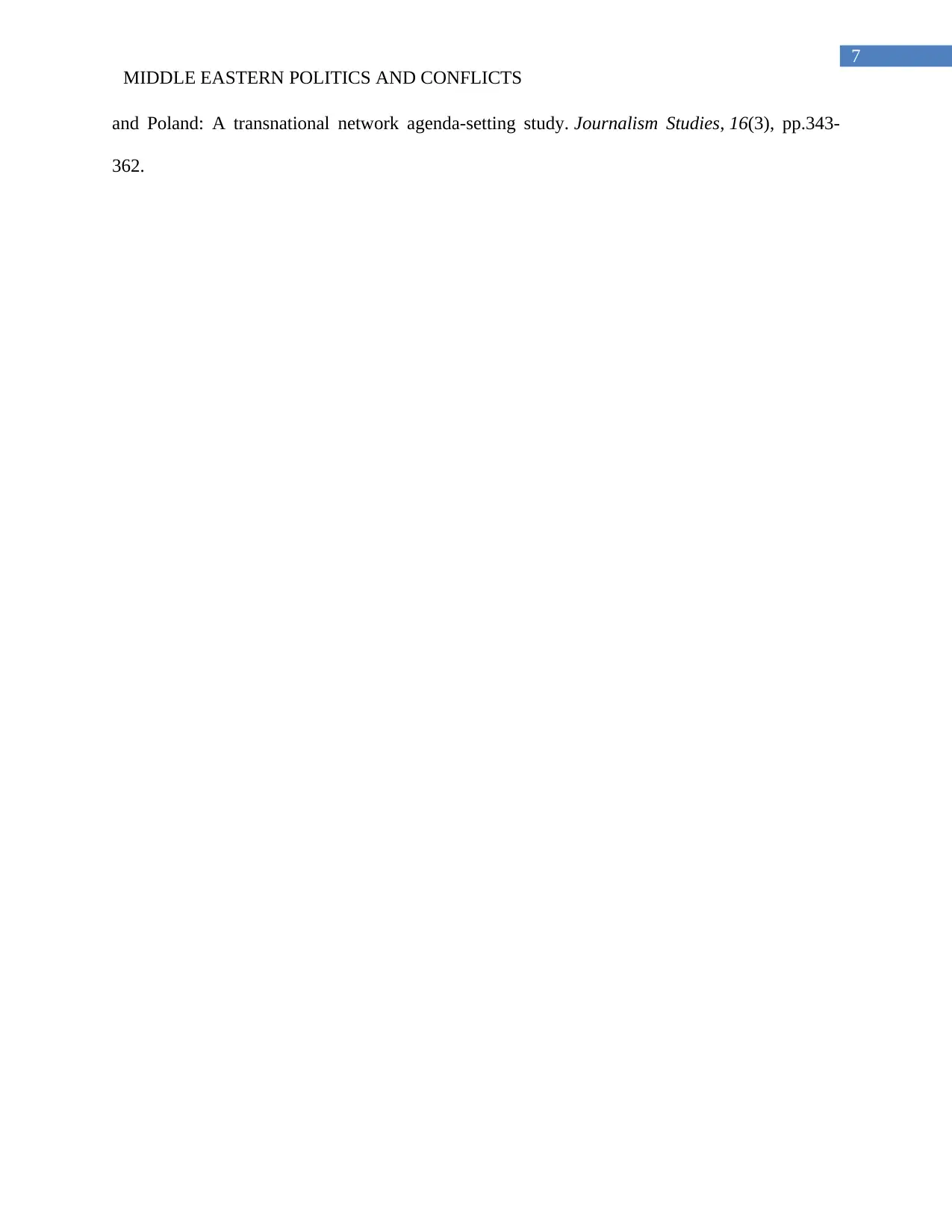
7
MIDDLE EASTERN POLITICS AND CONFLICTS
and Poland: A transnational network agenda-setting study. Journalism Studies, 16(3), pp.343-
362.
MIDDLE EASTERN POLITICS AND CONFLICTS
and Poland: A transnational network agenda-setting study. Journalism Studies, 16(3), pp.343-
362.
1 out of 8
Related Documents
Your All-in-One AI-Powered Toolkit for Academic Success.
+13062052269
info@desklib.com
Available 24*7 on WhatsApp / Email
![[object Object]](/_next/static/media/star-bottom.7253800d.svg)
Unlock your academic potential
© 2024 | Zucol Services PVT LTD | All rights reserved.





